 Are you an athlete who wants to know how to build Arm Strength for Baseball Players?
Are you an athlete who wants to know how to build Arm Strength for Baseball Players?
If so, you understand how important explosive arm strength is for throwing properly and with power. Building arm strength should be a top objective for all athletes, whether you're a pitcher aiming to improve your fastball speed or an outfielder looking to make those long, accurate throws. But where do you begin? our is where our comprehensive guide comes in. We'll delve deep into the most efficient workouts, training techniques, and strategies to help you develop the kind of arm strength that will make your opponents shudder in this comprehensive book. We'll go through everything from medicine ball exercises to resistance band workouts. Plus, we'll provide you with expert advice and ideas from professional baseball players and trainers who have had a lot of success on the field. Keep reading if you're ready to unleash your full potential and conquer the game with your explosive arm strength for baseball players.
Arm Strength for Baseball Players Is Important
Arm strength for baseball players is an important part of baseball that can have a big impact on your success on the field. A powerful arm lets you throw with greater precision, velocity, and distance than your opponents, providing you with a competitive advantage. Having explosive arm strength is vital for executing effective plays and making game-changing throws whether you're a pitcher, catcher, infielder, or outfielder. It not only improves your defensive ability, but it also helps your offensive game by allowing you to hit the ball with more strength. Not only can developing strong arm muscles boost your throwing velocity, but it will also assist prevent injuries by stabilizing your shoulder and elbow joints. You can improve your overall performance and become a more formidable player by prioritizing arm strength training.
The Truth About Arm Strength for Baseball Players
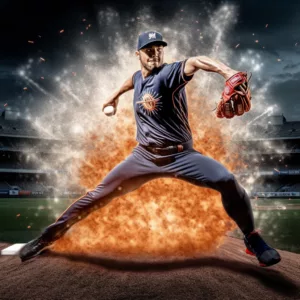 I completely believe that arm strength is crucial in baseball, especially when it comes to making accurate, high-velocity pitches or hitting with power. However, keep in mind that the word "arm strength," as it is commonly employed, may not fully encompass the scientific intricacy of a baseball throw or swing.
I completely believe that arm strength is crucial in baseball, especially when it comes to making accurate, high-velocity pitches or hitting with power. However, keep in mind that the word "arm strength," as it is commonly employed, may not fully encompass the scientific intricacy of a baseball throw or swing.
In truth, what we call "arm strength" is a highly coordinated, full-body exercise that strongly relies on the "kinetic chain." This word refers to a series of body motions that begin at the ground and progress up through the legs, torso, and finally the arm to efficiently generate and transfer energy. Each link in this chain is crucial to increasing the velocity of the throw or the power of the swing.
Strength and explosive force from the lower body and torso have a considerable influence on the last output - the arm action - in the kinetic chain. If the kinetic chain is working well, it can generate a significant amount of power before the arm is involved. The arm and hand then function as a whip, following the energy created by the rest of the body. While arm strength is important, it is only one component of a much wider biomechanical process.
As a result, I encourage players to think about "body strength" rather than just arm strength. Train your entire body to improve overall performance and reduce your risk of injury. After all, it's not just about the strength of your arms, but also about the explosive energy that your complete body can generate and convey during a game. Even so, we can continue to use the word "arm strength" because it is simple and familiar, but bear in mind the larger, more scientific fact it reflects.
Let's break down the primary benefits of arm strength for baseball players to understand its significance properly
Benefits of Explosive Arm Strength for Baseball Players
 Increased Throwing Velocity: The ability to throw the ball with greater velocity is one of the most significant advantages of explosive arm strength. A powerful throw can make or break a game, such as throwing out a runner attempting to steal a base or making a long-distance throw from the outfield. A stronger arm (body) allows you to generate more force and efficiently transfer it to the ball, resulting in faster throwing speeds.
Increased Throwing Velocity: The ability to throw the ball with greater velocity is one of the most significant advantages of explosive arm strength. A powerful throw can make or break a game, such as throwing out a runner attempting to steal a base or making a long-distance throw from the outfield. A stronger arm (body) allows you to generate more force and efficiently transfer it to the ball, resulting in faster throwing speeds.- Improved Accuracy: Along with velocity, arm strength is an important factor in throwing accuracy. You can improve your throwing mechanics and your ability to hit your target consistently by strengthening your arm (body) muscles. A strong arm (body) improves control and minimizes the likelihood of poor throws, allowing you to make precise, on-target throws to your teammates or to the bases.
- Longer Throwing Distance: Having explosive arm (body) power allows you to throw the ball farther without compromising accuracy or velocity. This is particularly important for outfielders who must make lengthy, accurate throws to home plate or cut-off men. By boosting your arm (body) strength, you'll be able to reach your target without sacrificing throw quality, giving your opponents less time to react and increasing your chances of executing effective plays.
- Increased Bat Speed: Arm strength improves not just your throwing skill but also your hitting performance. A strong arm (body) helps you generate more bat speed, which allows you to hit the ball with more force and distance. By incorporating arm (body) strengthening exercises into your training routine, you'll see improvements in your swing and be able to drive the ball with more force, potentially leading to more home runs and extra-base hits.
- Injury Prevention: Building arm (body) strength is not only about enhancing performance but also about preventing injuries. Baseball players are prone to shoulder and elbow injuries due to the repetitive throwing motion. By strengthening the muscles surrounding these joints, you can provide additional support and stability, reducing the risk of strains, tears, and other common baseball-related injuries. Additionally, a well-conditioned arm (body) can absorb and distribute forces more efficiently, minimizing the impact on your joints and reducing the chances of overuse injuries.
Now that we understand the importance and benefits of explosive arm (body) strength in baseball, let's explore the best exercises and training techniques to help you develop a powerful throwing arm.
Arm Strength for Baseball Players Training Exercises
When it comes to building arm (body) strength for baseball, a variety of exercises can target the muscles responsible for throwing power. Incorporating a combination of upper & lower body exercises, resistance band exercises, and medicine ball exercises into your training routine will help you develop a well-rounded arm (body) strength foundation. Let's take a closer look at each type of exercise.
Upper Body Workouts
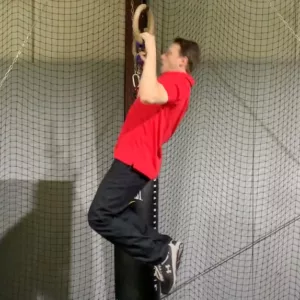 Upper body exercises are essential for building overall arm strength. These exercises primarily target the muscles in your shoulders, back, and chest, which play a significant role in generating power during a throw.
Upper body exercises are essential for building overall arm strength. These exercises primarily target the muscles in your shoulders, back, and chest, which play a significant role in generating power during a throw.
Some effective upper body exercises for arm strength development include:
- Push-Ups: Push-ups are a classic exercise that engages multiple muscle groups, including the chest, shoulders, and triceps. This exercise builds strength and stability in your upper body, helping you generate more force during a throw. Start with the traditional push-up position, with your hands slightly wider than shoulder-width apart. Lower your body until your chest hovers just above the ground, and then push back up to the starting position. Aim for three sets of 10-15 reps, gradually increasing the intensity as you get stronger.
- Pull-Ups: Pull-ups are a powerful upper-body workout that primarily targets the muscles in your back, specifically the lats, but also utilizes your shoulders, biceps, and forearms. By creating a strong and stable upper body, this workout can improve your throwing power. Begin by gripping the pull-up bar with your palms facing away from you and your hands shoulder-width apart. Hang fully extended, then lift yourself up, pulling your shoulder blades together at the top, until your chin is above the bar. Lower yourself back to the starting position in a controlled manner. If you're just starting out, do as many repetitions as you can with perfect form and progressively increase this over time. If you can't yet do a pull-up, start with assisted pull-ups or negative pull-ups to gain strength.
Lower Body Exercises
 Lower body workouts are just as important as upper body exercises for developing overall body strength. These exercises primarily target the muscles in your legs and hips, which constitute the foundation of the kinetic chain and generate tremendous force during a throw.
Lower body workouts are just as important as upper body exercises for developing overall body strength. These exercises primarily target the muscles in your legs and hips, which constitute the foundation of the kinetic chain and generate tremendous force during a throw.
The following are some good lower body workouts for strength development:
- Front Squats: Front squats are a great exercise for building lower-body strength, especially targeting the quadriceps but also engaging the glutes, hamstrings, and calves. This exercise also promotes strong posture and core stability, which are both necessary for effective throwing. Begin by holding a barbell across your chest with your elbows pointing forward to perform a front squat. Lower your body by bending at the knees and hips as if you were sitting back in a chair, with your feet shoulder-width apart. As you fall, slightly extend your knees until your thighs are parallel with the floor. Then, return to a standing position by pushing through your heels. Begin with three sets of 10-15 reps, increasing the weight progressively as you gain strength.
- Romanian Deadlifts are a powerful lower-body workout that primarily focuses the hamstrings and glutes while also engaging your lower back and core. This exercise helps to improve the posterior chain, which is essential for creating power during a throw. Begin by using an overhand grip on a barbell with your hands shoulder-width apart. Maintaining a straight back, thrust your hips back and bend at the waist to descend the barbell to the ground. Throughout the exercise, keep the barbell close to your body. Reverse the movement and return to standing, squeezing your glutes at the top, when you feel a stretch in your hamstrings. Aim for three sets of eight to twelve reps, gradually increasing the weight as you gain strength.
- Clean Pulls: Clean Pulls are a high-intensity exercise that builds lower-body power and explosiveness. This exercise works the quadriceps, hamstrings, and glutes, as well as the back and shoulder muscles. Begin with a barbell on the ground in front of you to conduct a clean pull. Squat with your feet hip-width apart and hold the barbell with an overhand grip. Your arms should be straight and your back arched slightly. Experiment with extending your hips, knees, and ankles while drawing the barbell up to your chest. Lower the barbell to the ground while maintaining control. Aim for three sets of 5-8 reps with a weight that allows you to keep control and perfect form throughout the exercise.
Resistance Band Exercises
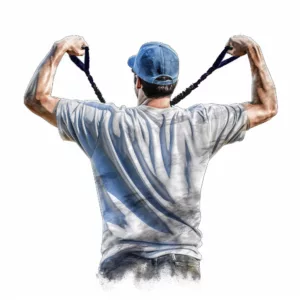 Resistance band exercises are a great way to build arm strength and improve shoulder stability. The bands provide constant tension throughout the movements, targeting the smaller stabilizer muscles in your shoulder and enhancing overall throwing power.
Resistance band exercises are a great way to build arm strength and improve shoulder stability. The bands provide constant tension throughout the movements, targeting the smaller stabilizer muscles in your shoulder and enhancing overall throwing power.
Here are a few effective resistance band exercises for arm strength development:
- Band Pull-Aparts: This exercise targets the muscles in your upper back and shoulders, helping to improve posture and shoulder stability. Stand with your feet shoulder-width apart, holding a resistance band in front of you with both hands. Keep your arms extended at shoulder height, and slowly pull the band apart until your arms are fully extended to the sides. Squeeze your shoulder blades together as you do this, then return to the starting position. Aim for three sets of 12-15 reps, gradually increasing the resistance band tension as you get stronger.
- Band Shoulder External Rotation: This exercise specifically targets the rotator cuff muscles, which play a crucial role in shoulder stability and injury prevention. Attach a resistance band to a stationary object at waist height. Stand perpendicular to the band and hold it with your arm bent at a 90-degree angle, elbow tucked into your side. Keeping your elbow stationary, rotate your forearm away from your body against the resistance of the band. Slowly return to the starting position. Perform three sets of 10-12 reps on each arm, focusing on proper form and control.
Medicine Ball Exercises
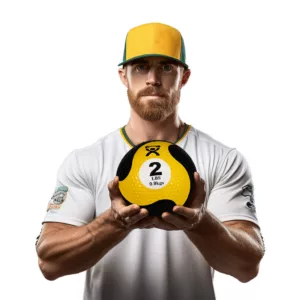 Medicine ball exercises are excellent for developing explosive arm (body) strength and improving rotational power. These exercises mimic the movements involved in throwing, making them highly specific and beneficial for baseball players. Here are a couple of effective medicine ball exercises for arm strength development:
Medicine ball exercises are excellent for developing explosive arm (body) strength and improving rotational power. These exercises mimic the movements involved in throwing, making them highly specific and beneficial for baseball players. Here are a couple of effective medicine ball exercises for arm strength development:
- Medicine Ball Slam: This exercise primarily targets the muscles in your core, shoulders, and triceps. Stand with your feet shoulder-width apart, holding a medicine ball in both hands. Raise the ball above your head, fully extending your arms, and then forcefully slam it down to the ground as hard as you can. Catch the ball on the bounce and repeat the movement for the desired number of reps. Aim for three sets of 8-10 reps, focusing on explosive power and full-body engagement.
- Medicine Ball Rotational Throws: This exercise focuses on improving rotational power and engaging the muscles involved in generating torque during a throw. Stand perpendicular to a wall with your feet shoulder-width apart, holding a medicine ball with both hands at chest level. Rotate your torso away from the wall, and then explosively rotate back, throwing the ball against the wall with maximum force. Catch the ball on the rebound and repeat the movement for the desired number of reps. Perform three sets of 6-8 reps on each side, gradually increasing the power and speed of the throws.
Proper Technique and Form for Arm (Body) Strengthening Exercises
 While performing arm (body) strengthening exercises, it's crucial to maintain proper technique and form to maximize their effectiveness and minimize the risk of injury. Here are some essential tips to keep in mind:
While performing arm (body) strengthening exercises, it's crucial to maintain proper technique and form to maximize their effectiveness and minimize the risk of injury. Here are some essential tips to keep in mind:
- Warm-up: Always start your workouts with a dynamic warm-up routine to prepare your muscles for the upcoming exercises. Incorporate exercises that increase blood flow, target shoulder mobility, and activate the muscles you'll be training.
- Focus on Control: During each exercise, prioritize control and proper form over the amount of weight or resistance. Performing exercises with proper technique ensures that you're targeting the intended muscles and reducing the risk of strain or injury.
- Gradually Increase Intensity: As you get stronger, gradually increase the intensity of your workouts by increasing the weight, resistance, or repetitions. Progression is key to continued growth and improvement. If you want more advanced programming for better gains see the programs below.
- Breathe Properly: Pay attention to your breathing during exercises. Exhale during the exertion phase (lifting or pushing) and inhale during the relaxation phase (lowering or returning to the starting position).
- Rest and Recover: Allow your muscles adequate time to rest and recover between workouts. Overtraining can lead to injuries and hinder your progress. Aim for at least one to two days of rest per week and incorporate active recovery exercises or mobility work on rest days.
- Listen to Your Body: If you experience any pain or discomfort during an exercise, stop immediately and consult a healthcare professional or trainer. Pushing through pain can exacerbate injuries or lead to new ones.
By following these guidelines and maintaining proper technique and form, you'll optimize your arm-strengthening exercises and ensure safe and effective progress.
Incorporating Plyometric Exercises for Explosive Arm (Body) Strength
 Plyometric exercises are explosive movements that involve rapid stretching and contracting of muscles, resulting in increased power and force production. Incorporating plyometric exercises into your training routine can significantly enhance your explosive arm strength.
Plyometric exercises are explosive movements that involve rapid stretching and contracting of muscles, resulting in increased power and force production. Incorporating plyometric exercises into your training routine can significantly enhance your explosive arm strength.
Here are a few plyometric exercises that can benefit baseball players:
- Medicine Ball Chest Pass: This exercise targets the chest, shoulder, and tricep muscles while focusing on explosive power. Stand facing a wall with your feet shoulder-width apart, holding a medicine ball at chest level. Extend your arms explosively, throwing the ball against the wall with maximum force. Catch the ball on the rebound and repeat the movement for the desired number of reps. Aim for three sets of 8-10 reps, focusing on speed and power.
- Box Jumps: Box jumps primarily target the lower body but also engage the upper body, including the arms and shoulders. Stand in front of a sturdy box or platform with your feet shoulder-width apart. Bend your knees, swing your arms back, and explosively jump onto the box, landing softly with both feet. Step down from the box and repeat the movement for the desired number of reps. Perform three sets of 8-10 reps, focusing on explosive power and proper landing mechanics.
- Depth Push-Ups: Depth push-ups are an advanced variation of traditional push-ups, adding an explosive element to the exercise. Start in a push-up position with your hands on elevated platforms, such as dumbbells or plyo boxes. Lower your chest towards the ground, and then explosively push off the platforms, aiming to lift your hands off the surface momentarily. Land back on the platforms and repeat the movement for the desired number of reps. Aim for three sets of 6-8 reps, gradually increasing the height of the platforms as you progress.
Nutrition and Hydration for Optimal Arm Strength for Baseball Players
 Proper nutrition and hydration are crucial for optimal arm strength development and overall athletic performance. To support your training efforts and maximize gains, consider implementing the following nutritional strategies:
Proper nutrition and hydration are crucial for optimal arm strength development and overall athletic performance. To support your training efforts and maximize gains, consider implementing the following nutritional strategies:
- Adequate Protein Intake: Protein is essential for muscle repair and growth. Aim to consume a sufficient amount of high-quality protein sources, such as lean meats, poultry, fish, eggs, dairy products, legumes, and plant-based proteins. Aim for approximately 0.8-1 gram of protein per pound of body weight.
- Balanced Macronutrient Intake: Ensure that your diet includes a balanced mix of carbohydrates, proteins, and healthy fats. Carbohydrates provide the energy needed for intense workouts, while healthy fats support hormone production and joint health. Focus on consuming whole grains, fruits, vegetables, lean proteins, nuts, seeds, and healthy oils. If you need supplementation of these nutrients checkout the TopVelocity Supplements.
- Hydration: Proper hydration is essential for maintaining optimal performance and preventing muscle cramps and fatigue. Drink water throughout the day, and make sure to hydrate before, during, and after workouts. Electrolyte-rich drinks can also be beneficial, especially during intense training sessions or hot weather.
- Pre- and Post-Workout Nutrition: Fueling your body before and after workouts can enhance your performance and aid in recovery. Consume a balanced meal or snack containing carbohydrates and protein before your training sessions to provide energy and support muscle repair. After workouts, prioritize a post-workout meal or snack rich in protein and carbohydrates to replenish glycogen stores and initiate the recovery process.
- Supplementation: While a well-balanced diet should provide most of the necessary nutrients, certain supplements can support your arm strength development. Consult with a healthcare professional or sports nutritionist to determine if supplements such as creatine, beta-alanine, or branched-chain amino acids (BCAAs) may be beneficial for your specific needs.
Remember, nutrition is highly individualized, and what works for one person may not work for another. Experiment with different approaches, listen to your body, and seek guidance from a qualified professional to optimize your nutrition for arm strength development.
Rest and Recovery for Preventing Injuries and Promoting Muscle Growth
 Rest and recovery are vital components of every training program, including the development of arm (body) strength. Adequate rest permits the muscles you've worked out to heal and expand. Without adequate rest, your muscles will be unable to recover and strengthen, restricting your growth and potentially leading to overuse problems.
Rest and recovery are vital components of every training program, including the development of arm (body) strength. Adequate rest permits the muscles you've worked out to heal and expand. Without adequate rest, your muscles will be unable to recover and strengthen, restricting your growth and potentially leading to overuse problems.
Several variables must be considered for proper recovery:
- Sleep: 7-9 hours of quality sleep per night is recommended. During sleep, your body produces growth hormone, which aids in the repair and rebuilding of muscular tissue. Sleep deprivation can have a negative impact on recuperation and muscle building.
- Nutrition: A well-balanced diet is essential for muscle repair and growth. Protein is very important since it contains the building blocks for muscle repair. Don't forget to include carbohydrates and healthy fats in your diet, as these will offer energy for your workouts and daily activities.
- Hydration: Drink plenty of water before, during, and after your workout. Many biological functions, including nutrient delivery and muscle rehabilitation, rely on hydration.
- Active Recovery: Active recovery might include light activity such as leisurely walking or cycling, stretching, and mobility work. Active recovery can increase blood flow to the muscles, aiding in the healing process.
- Rest Days: Make time in your training schedule for rest days. These are days when you do nothing or very little physical exercise, allowing your muscles to properly heal.
Remember that rest and recovery are not synonymous with sloth or idleness. They are important components of a well-rounded training regimen that promotes muscular growth, improves performance, and prevents injuries. Don't overlook these parts of your training because they are just as vital as the workouts themselves.
Arm Strength for Baseball Players with 3X and 2X Velocity Programs
 If you're serious about improving your baseball play, we have the ideal options for you. Our 3X Pitching Velocity Program for pitchers and 2X Velocity Program for position players are specifically developed to assist you in increasing your arm (or rather, body) strength and unlocking your maximum athletic potential.
If you're serious about improving your baseball play, we have the ideal options for you. Our 3X Pitching Velocity Program for pitchers and 2X Velocity Program for position players are specifically developed to assist you in increasing your arm (or rather, body) strength and unlocking your maximum athletic potential.
These comprehensive programs are designed to improve your kinetic chain efficiency, with thorough training regimens targeting each link in the chain, from your legs and hips to your chest and arms. We understand that baseball is about more than simply arm power, which is why our programs include upper and lower body strength, core stability, flexibility, and good pitching mechanics.
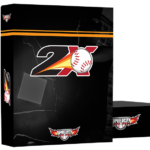 Beyond strength training, these programs include important components of performance such as nutrition, rest, recovery, and injury prevention, giving you a complete set of tools to become the greatest athlete you can be. We continue to believe that a strong, well-conditioned physique is the key to increased baseball performance and longevity.
Beyond strength training, these programs include important components of performance such as nutrition, rest, recovery, and injury prevention, giving you a complete set of tools to become the greatest athlete you can be. We continue to believe that a strong, well-conditioned physique is the key to increased baseball performance and longevity.
We invite you to try the 3X Pitching Velocity Program for pitchers and 2X Velocity Program for position players today if you're ready to work smarter, not harder, and enhance your whole body strength to throw harder, run quicker, and play better. Let's work together to push your boundaries and reach your baseball goals.
Don't put off improving your performance any longer. Visit our website today to learn more about these programs and to get started on your path to becoming a stronger, faster, and more explosive baseball player!
If you are interested in a video analysis signup for the TopVelocity Patreon and receive weekly video analysis!


 Increased Throwing Velocity: The ability to throw the ball with greater velocity is one of the most significant advantages of explosive arm strength. A powerful throw can make or break a game, such as throwing out a runner attempting to steal a base or making a long-distance throw from the outfield. A stronger arm (body) allows you to generate more force and efficiently transfer it to the ball, resulting in faster throwing speeds.
Increased Throwing Velocity: The ability to throw the ball with greater velocity is one of the most significant advantages of explosive arm strength. A powerful throw can make or break a game, such as throwing out a runner attempting to steal a base or making a long-distance throw from the outfield. A stronger arm (body) allows you to generate more force and efficiently transfer it to the ball, resulting in faster throwing speeds.